- Salt Pork vs Pork Belly: Which Is Better? - September 1, 2021
- Ham vs Pork Explained: The Ultimate Guide - August 28, 2021
- Russian Sausage Guide and History: Best Types and Recipes - August 25, 2021
While civilizations all over the world have their own different kinds of blood sausages, we’re going to talk about the German variant, known as the Blutwurst. These sausages are famous all over the world for their rich taste and the wide range of flavor profiles they offer. If you look at all the recipes there are for them, you’ll realize that pretty much the only thing those recipes have in common is that they require some kind of animal blood to be added to the sausage.
History of the Blutwurst
The blood sausage is thought to be the oldest known sausage variety, and it has a very bloody reputation even when it comes to its creation and popularization. Soldiers on ancient battlefields prepared Blutwurst for themselves, and it’s even mentioned in literature as old as The Odyssey by Homer.
When meat and food were scarce, like in times of war, blood sausages were made by cooking together all parts of an animal that could provide someone with nutrition, and then certain “fillers” like wheat or barley were added to them too. Even today, the meat from a pig’s head and jowl area is used for the sausages, and of course, blood is also added.
With time, the Blutwurst became less of survival food and the people grew to love it. It was eaten as a festival food in the Roman Empire, which is why people attempted to ban the sausage because of its ties to “pagan festivals” in the middle age. The ban didn’t last long though, and blood sausages are still popular all over the world.
Blutwurst – The Basics
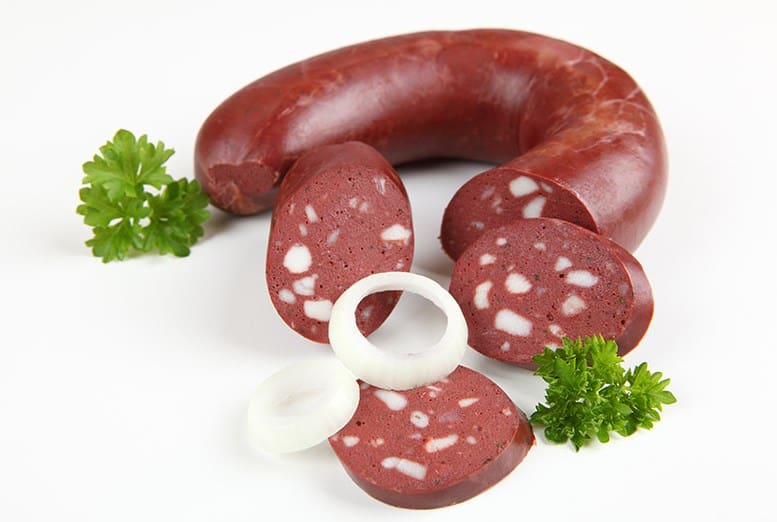
Blutwurst today is a cooked sausage served cold. There are other varieties of blood sausage like the French version that are served warm, and the British blood pudding, but don’t confuse them with the Blutwurst.
It’s a heavily spiced sausage that has animal meat, fat, blood, fillers like barley, wheat, and bread, and onions and spices inside a sausage casing.
The sausage usually comes in two varieties, one sliced and one non-sliced version. Both are eaten and served differently, and the method for preparation, taste and even cost of production differs. The non-sliced version is cheaper to manufacture, which is why it’s more popular than the sliced version.
Cultural Significance
For countless households all over the world, one version of the blood sausage or another is a household thing. People who love this sausage are usually those who grew up with the Blutwurst or blood pudding as part of their diet, which is why they developed a taste for the bloody dish.
For many households, it’s a common thing to have this sausage prepared and kept for consumption later – typically as a side dish or a snack. Though other types of sausages and dishes like the Currywurst are more popular, the blood sausage has its own place in the German food scene.
What Does Blutwurst Look Like?
You can usually tell the Blutwurst apart from almost all other varieties of sausage because of its distinctive dark color. A Blutwurst can be anywhere from dark red to almost black.
If you slice one sausage open, you’ll notice a marble-like structure not too different from that of salami. The light patches in blood sausage are there not only because of the added fat but also because of other fillers. They were originally added to the recipe to increase the volume of the sausages, especially in times of war and food shortages, but now they’re included in the recipe to enhance the Blutwurst’s taste and flavor.
What Does Blutwurst Taste Like?
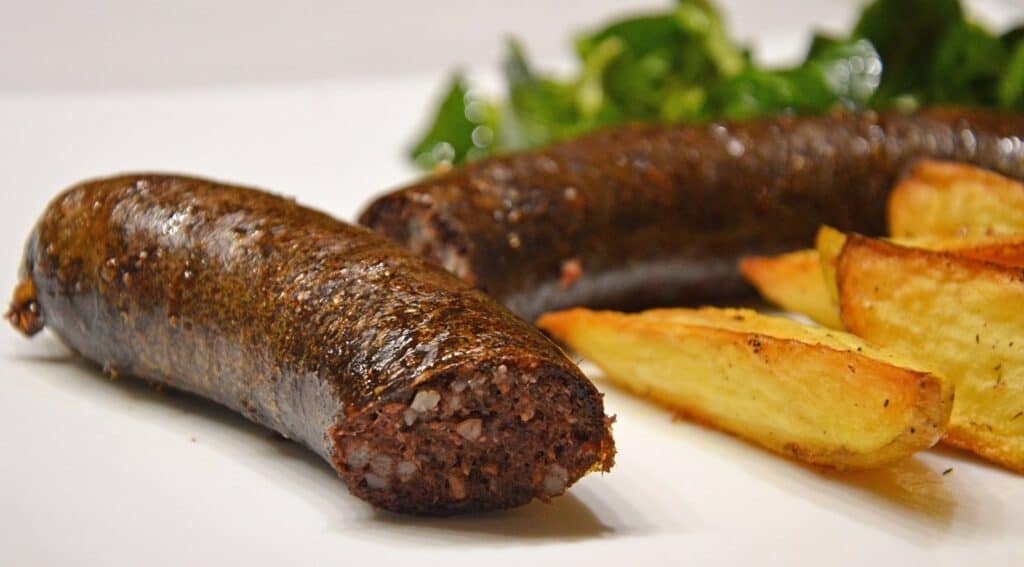
German sausages in the general pack a solid punch when it comes to flavor, and the Blutwurst is no different. But even by those standards, the Blutwurst stands out from the bunch.
Many people are left with a strong metallic aftertaste when they eat a bite of the sausage, and many don’t. Its texture is also different – don’t expect something firm and chewy like the Bratwurst. On the contrary, many people feel like blood sausages don’t taste like meat sausages at all. This is because of the soft texture of the Blutwurst, caused by the blood added to an already finely ground mixture of meat and spices.
Some versions of blood sausages around the world may also have a firmer texture, which comes from modern recipes calling for dried blood for a more consistent taste and result, but that’s not how the classic Blutwurst is supposed to taste like in my opinion.
The Blutwurst is an acquired taste for many, and its taste is quite the shock for someone who’s tasting Blutwurst for the first time, so be prepared!
Types of Blutwurst
There are two types of Blutwurst.
- The sausage version
- The sliced version
Both of them are made in different ways and served differently. The sausage version is more common and cheaper, but the sliced version isn’t by any means unpopular.
How to Make Blutwurst
In this section, I’m going to go through how you can make Blutwurst at home, and I’m also going to talk about how they’re commercially produced.
Blutwurst at Home
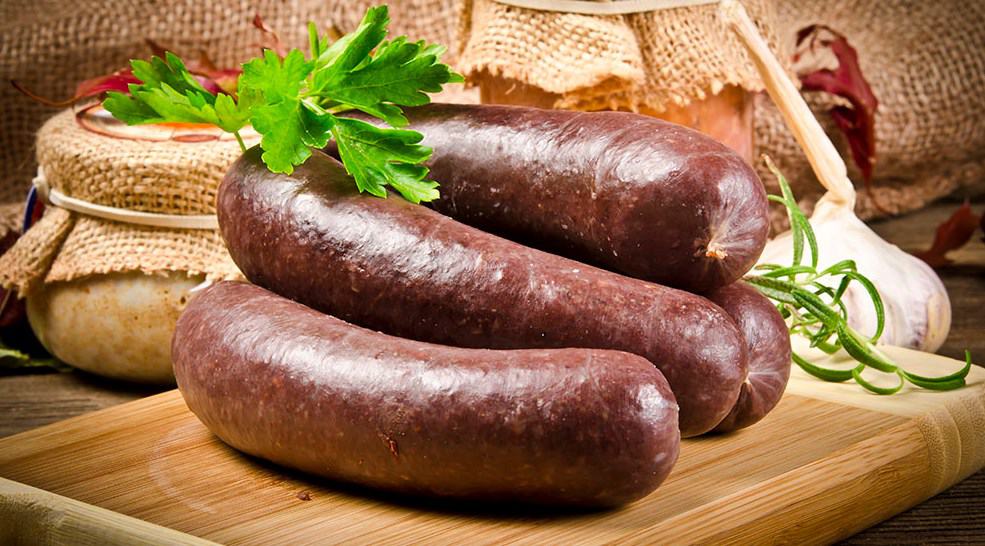
Making Blutwurst at home requires more or less the same ingredients as industrial Blutwurst, but of course in lesser quantities, and you have more control over the end result. Here are the ingredients needed for Blutwurst
- 3lb fresh fat pork belly
- 1lb fresh lean pork
- 1 chopped onion
- 1-pint fresh pork blood
- Pepper
- Ginger
- Sal
- Clove
- Pork casing
Cook half of the fat pork and all of the lean pork together in a pan after cutting it up, and simmer on slow heat after you’re convinced it’s cooked until the fat melts. Grind this concoction and gradually mix in the blood, spices, and the remaining fat pork. Once the mixture is ready, you can fill the casings with it and tie them up. Then put them in water and bring it to a boil, after which you need to simmer the sausages for almost half an hour.
Blutwurst Manufacture
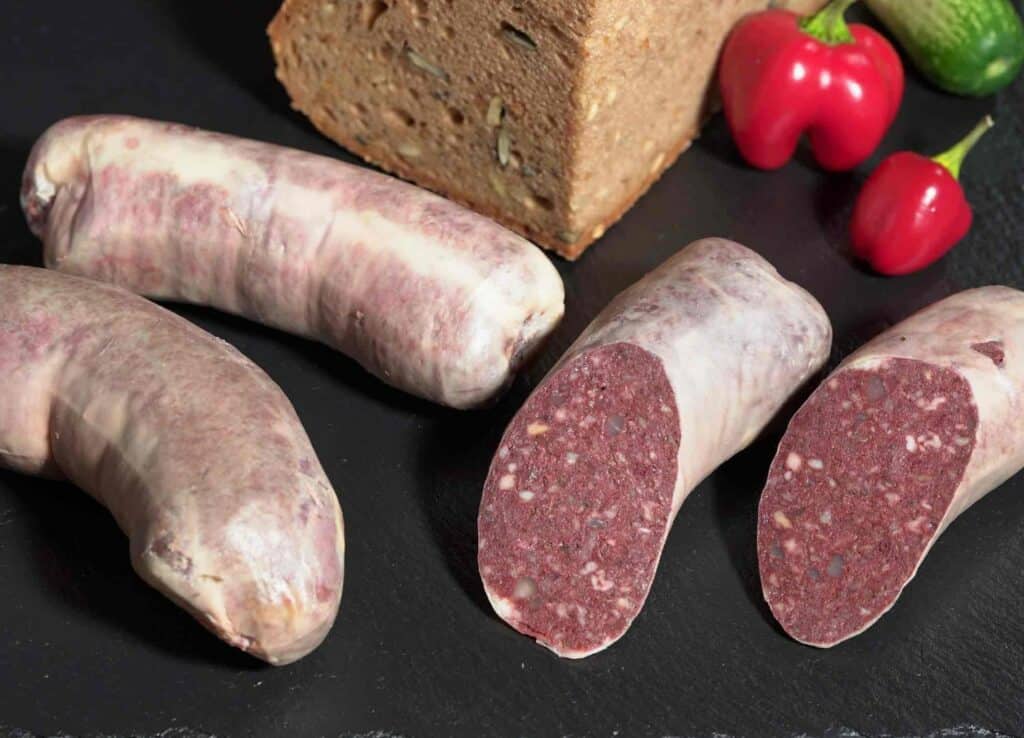
When preparing Blutwurst at an industrial level, meat is taken from different parts of the pig depending on what kind of Blutwurst we’re trying to prepare.
Sliced Version
For the sliced version, meat and fat are taken from the head and tongue, and back fat and pork skins might be added to the mix along with the meat.
Sausage Version
Meat and pork skins are taken from other parts of the pig, usually parts that are the cheapest to get. Hard fat from the back of the pig is used since it doesn’t smear and has a hard consistency, which keeps the Blutwurst from being softer than it has to be. There’s a high chance of fillers like oatmeal, barley, breadcrumbs, or flour being added to the sausage mixture. This keeps the sausage hard and firm and improves the taste too.
How to Eat Blutwurst
Blutwurst is a cooked sausage that can be eaten in a variety of different ways, either cold or hot. It’s usually served with other foods as a side dish and sometimes even used in dishes that call for regular sausages as a richer, more interesting substitute.
As far as safety goes, Blutwurst is a cooked sausage that’s ready to eat as soon as you take it out of the bag or are finished preparing it.
It’s served with things like baked potatoes, mashed and fried to eat with french fries, and as part of a Charcuterie board. A lot of people like to eat Blutwurst with sauces like apple sauce and served with other accompanying vegetables like fried onions or cabbage.
In the next section, I’m going to list various suggestions on how to serve and eat Blutwurst.
Blutwurst Pairing Options and Dishes
The Classic Way
The most common way to eat Blutwurst is to pair it with some apple sauce and mashed potatoes. The strong and metallic flavor of the Blutwurst – that many consider too much for them – is perfectly balanced with the rich and creamy texture of the mashed potatoes and the sweet and tangy apple sauce.
With French Fries
If you want to eat Blutwurst with something more filling, try serving it deconstructed with some french fries. This is how the English eat their blood sausages or blood pudding, and it’s not half bad! Once again, the potatoes balance the strong flavors of the Blutwurst.
In Omelettes

You can use Blutwurst as an ingredient in your breakfast omelets. Add other things like fried potatoes, bacon, eggs, and Blutwurst in a pan and fry it all with butter. The resulting dish is delicious and the perfect breakfast when you’re feeling adventurous. In my experience, Blutwurst adds a little extra to almost every dish it’s added to. It’s unlike any other dishes and flavors you would come across, and it packs a solid punch. This is why you need to be careful about how much of it you add to things as well.
On a Charcuterie Board
Sausages, hams, and other cold cuts are one of the main parts of a charcuterie board, which is a board with different cheeses, meats, and other condiments laid out. The thinly sliced version of Blutwurst is served cold on the board, ready to be paired with various types of cheeses and snacks.
With Different Vegetables and As an Ingredient in Dishes
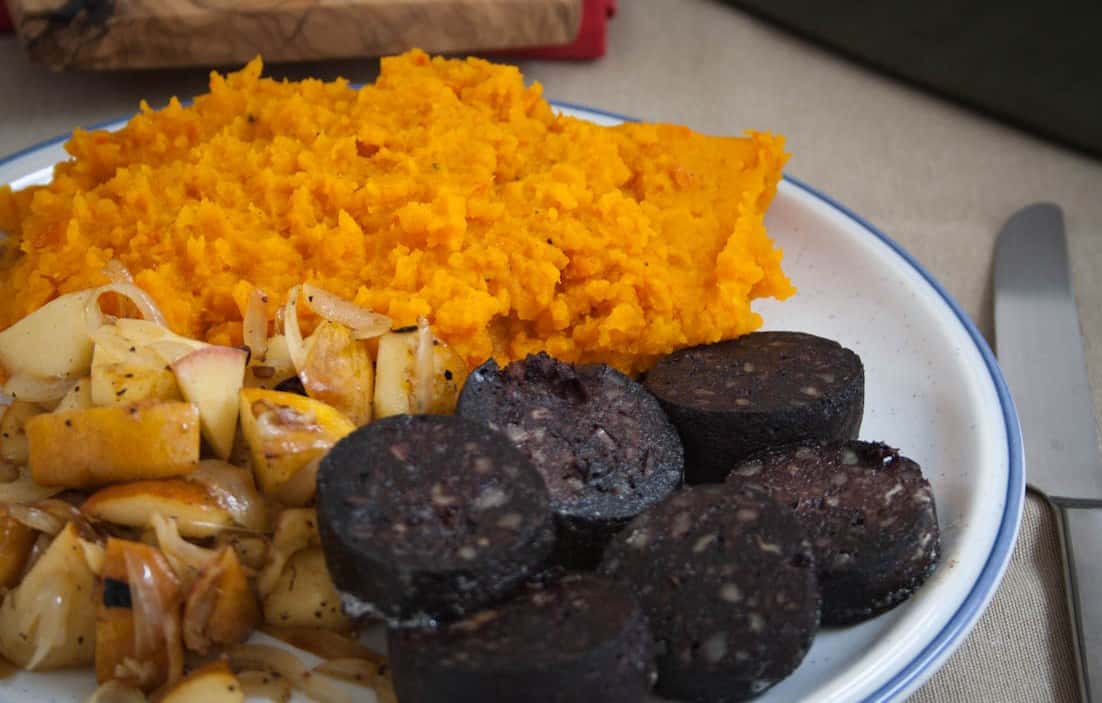
Once you get used to its flavor, you’ll start seeing various ways in which you can incorporate Bratwurst in your daily cooking. You can add it to soups, serve it with caramelized onions, or even add thin slices in salads.
As an Alternate to Sausages
If you’re bored of the plain old sausages in your food, try adding Blutwurst to the same recipes for an interesting twist. Be careful about how much you add though since Blutwurst has a really strong flavor that not everyone can eat.
Blutwurst Alternatives
If you feel like the Blutwurst is too intense for you, there are many other alternatives you can try that are just as interesting.
Boudin Blanc
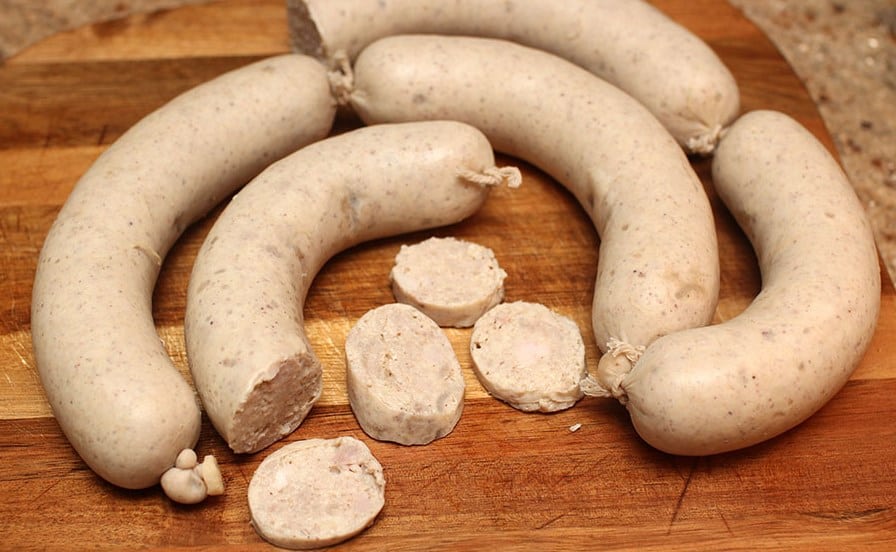
If you like the soft texture of the Blutwurst but the taste or the blood inside it puts you off, try the french sausage, Boudin Blanc, instead. With a Blutwurst-like consistency, it has none of the blood. In fact, the Boudin Blanc looks completely white in most cases. That’s because the recipe calls for milk or cream, starch, eggs, and spices.
It has more or less the same consistency as the Blutwurst, but the taste couldn’t be more different. Give it a try if you want a milky, creamy sausage instead of a bloody one.
Vegan Blutwurst
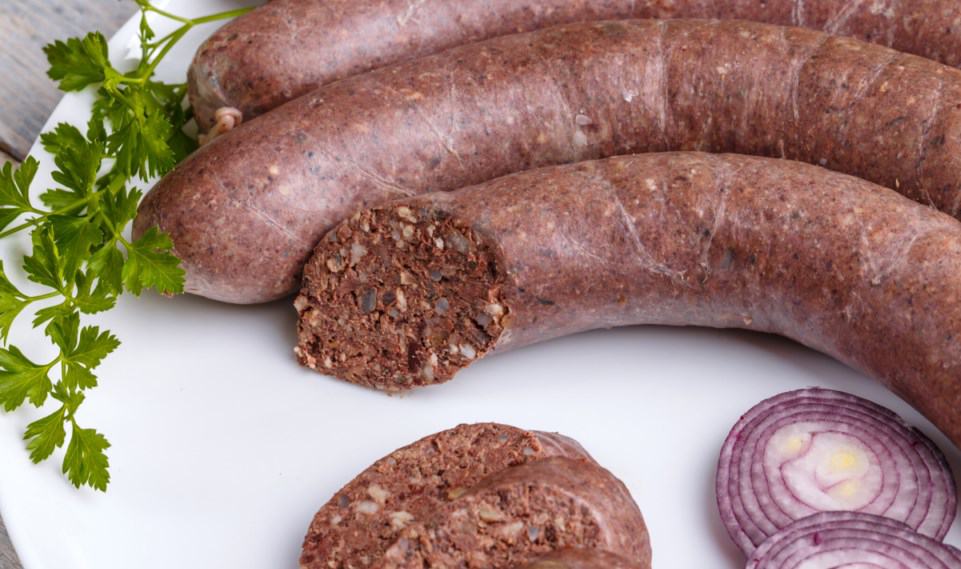
While many argue that vegan Blutwurst can’t be called true Blutwurst, it does exist and it may be the perfect choice for anyone who wants to taste the delicacy but is less than excited about the blood it contains. The vegan option is also great if you’re looking for a halal or kosher alternative to blood sausages.
The vegan version of the Blutwurst contains herbs and a plant-based concoction made out of mushrooms, black beans, onions, and spices. The only real difference between this recipe and the original one is how they replace meat and blood with mushrooms and black beans, and I reckon they replace the meaty flavor with the help of herbs and artificial flavors. That said, I can’t imagine it tasting the same as the original recipe.
FAQs
Question: Is Blutwurst Halal?
Answer: The main ingredient in Blutwurst is pig’s blood. It also contains pork and blood from other animals. Anything that contains even cow’s blood can’t be considered Halal, which is why blood sausages all over the world including Blutwurst are off the menu for many practicing Muslims and Jews.
Question: Is Blutwurst ready to eat?
Answer: Yes! Blutwurst is a variety of cooked sausage that is cooked and boiled both before and after the fillings go into the sausage casing. This is why they’re often served cold on Charcuterie boards and eaten as they are with fried vegetables.
That said, Blutwurst is also grilled or fried one more time right after serving it hot with french fries, or with applesauce and mashed potatoes. It’s entirely up to you whether you prefer it hot or cold, but it’s essentially a cooked sausage that’s ready to eat.
Question: What does Blutwurst taste like?
Answer: Blutwurst has a strong, metallic taste that can be a little intense if you’re eating it for the first time. Many people who have tried it say that it doesn’t taste like meat at all, and even the people who like it prefer to pair it with side dishes and things that mellow out the intense flavor of the sausage.
Question: How is Blutwurst made?
Answer: Blutwurst is made by grinding and cooking pork, onions, herbs, and pig’s blood together. Pork fat and fillers like oats, barley, or breadcrumbs are added as well. All these ingredients are then stuffed into sausage casings and the whole thing is boiled again to make sure it’s firm and intact.
Question: Is Blutwurst healthy?
Answer: Blutwurst isn’t very healthy. It has a high-fat content, lots of spices, and even animal blood inside it, which is why it needs to be consumed in careful amounts, especially if it’s part of your daily diet. The recipe itself originated to make use of all parts of an animal during food shortages and wars, which means no one paid much mind to make it healthy. Instead, the Blutwurst was an easy and efficient way to fill their stomach.
Should You Try Blutwurst?
If you’re interested in trying interesting new things and are a fan of unique flavors, well, you’re not going to find anything quite like the Blutwurst. When you do try it, make sure to prepare it properly and eat it with something on the side. This way you’ll be able to enjoy the unique flavor of the Blutwurst without it being too overpowering or unpleasant.

